Welcome back to the Mirror Gallery on this beautiful June Thursday. Even though we’re barely through Modern Horizons, the full card image gallery for Core Set 2020 is already out. While perusing the new cards, I noticed something that’s going to allow me to begin a series I’ve wanted to write for some time.
If you’re a regular reader you know that I like basic lands, and I think that their artistic storytelling capabilities are some of the strongest in the game. You also know that I like looking at large groups of art and distilling them down into my favorites, as seen in my Grand Art Tours. Well some of my favorite basic lands in all of Magic have been reprinted in Core Set 2020, and it seems like the perfect opportunity to talk about them. This was also partially inspired by working with fellow Hipsters writer Ryan Sainio on articles about our favorite Planeswalker art, as well as John Dale Beety’s 2018 article On Swamps. I’m eventually going to do this with each basic land type, scouring the hundreds of options and finding my twelve favorites; whether it’s their artistic mastery, those that I feel tell the best stories, or those lands that I’m most likely to play in one of my themed Commander decks.
Having been around the game for the last fifteen years I’ve seen lots of lands come and go, and I’m very excited to tell you about those I enjoy most. We won’t have any new basics until Commander 2019 at the very soonest, so it’s a perfect time to look back at everything that’s come so far. Without further ado, I invite you to join me for this first installment in the Mirror Gallery Curator’s Choice, Picking Plains.
At a Glance: Basic Plains
According to Scryfall, there have been 201 unique illustrations of Basic Plains as of Core Set 2020. Those have been “printed” 505 different times between paper, promos, and Magic Online.
Traditionally we think of a plain as a large, flat area of land with a few sparse trees or rocks. There are dozens of synonyms, many of which have found their own Magic card: savannah, grassland, meadow, prairie, and steppe. Artistically, many of Magic’s Plains fall into these broad categories. But there are also just as many representing their specific plane environments, looking nothing like their stereotypical counterparts yet still staying true to their core definition. You’ll see a bit of both in the following list, in no particular order. Let’s begin!
Plains #337 (Commander 2016) by Rebecca Guay
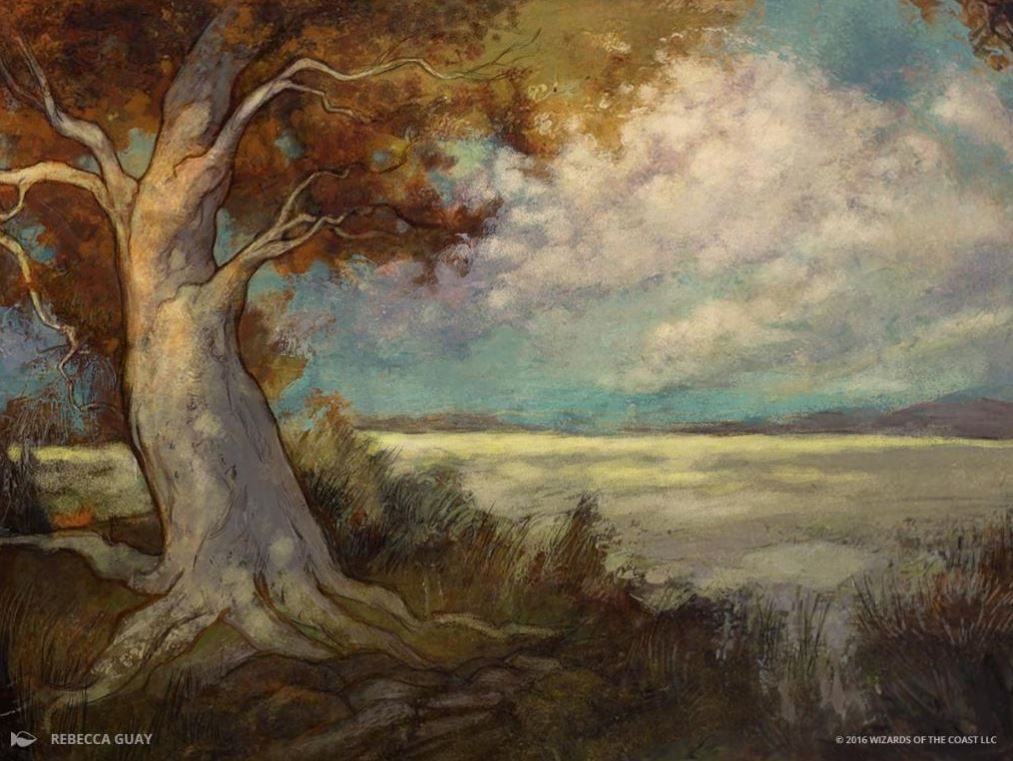
Plains #337 (Commander 2016) by Rebecca Guay. Traditional. Private Collection.
The lands of legendary Magic artist Rebecca Guay hit the community with a burst of excitement, instantaneously becoming one of the most popular cycles of basic lands in Magic’s history. They have appeared as MTGO promos, in two Commander expansions, and as foil versions for the Standard Showdown and Treasure Chest booster packs. Of the five, the Plains is my favorite, and actually one of my favorite Plains in Magic. Although there is a tree in the foreground, this work is noticeably not a Forest.
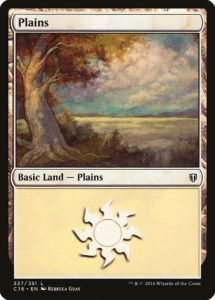
Guay’s composition draws your eye from the bottom right, up the tree trunk into the autumnal boughs, and then back upon the great expanse and setting sun. It’s a lovely painting, and one that will always have a home in my decks.
Plains #285 (Lorwyn) by Omar Rayyan
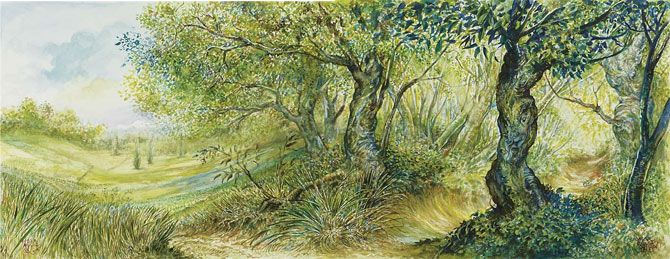
Plains #285 (Lorwyn) [with Forest #298 (Lorwyn)] by Omar Rayyan. Traditional. Private Collection.
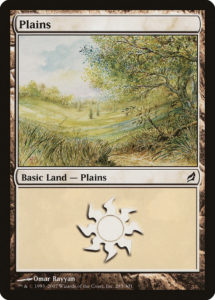
This is not only one of my favorite Plains but one of my favorite artworks in Magic, a snapshot of a fantastic illustrator’s contributions to the game during one of its most artistically beloved sets.
Plains (Dragon’s Maze Promo) by Eric Deschamps
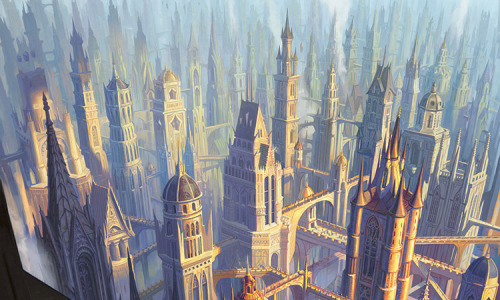
Plains (Dragon’s Maze Promo) by Eric Deschamps. Digital.
Each Ravnica set in Magic’s history has been a pioneer in terms of Basic Lands, reinventing the way in which we see these fantasy worlds and creating new frontiers for artists and fans of the game alike. During Magic’s second visit to the plane we got this incredible land, a view of the Implicit Maze in all its glory as a promo for Dragon’s Maze. There is so much going on here as spires intersect and reach for the sky. Yet Deschamps has made the artwork perfectly balanced, pulling your eye straight into the focal point and then allowing it to wander through the streets. This is another must-use land for a Ravnican Commander, and a shining example that not all Plains must appear as meadow-y grasslands to portray a source of white mana.
Plains #232 (Magic 2013) by Nils Hamm
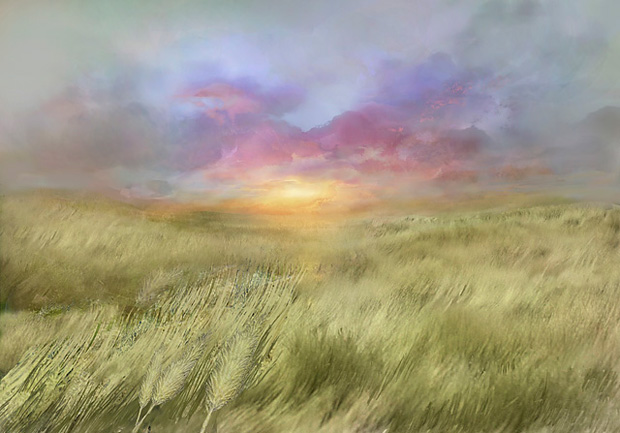
Plains #232 (Magic 2013) by Nils Hamm.
This painting is one of Magic’s Impressionistic all-stars, and for me it’s that little hint of purple that puts this piece over the top. Across Magic’s Plains we see many at sunrise or sunset, but the blending of these raw colors that span the entire spectrum is something that makes Hamm’s Plains truly special. This is Rhystic Studies’ go-to White Basic Land, and has just been reprinted for the seventh time in Core Set 2020, in case you want to make it yours as well. It’s a solemnly stunning setting of the classic landscape.
Plains (Magic Fest 2019) by Sam Burley
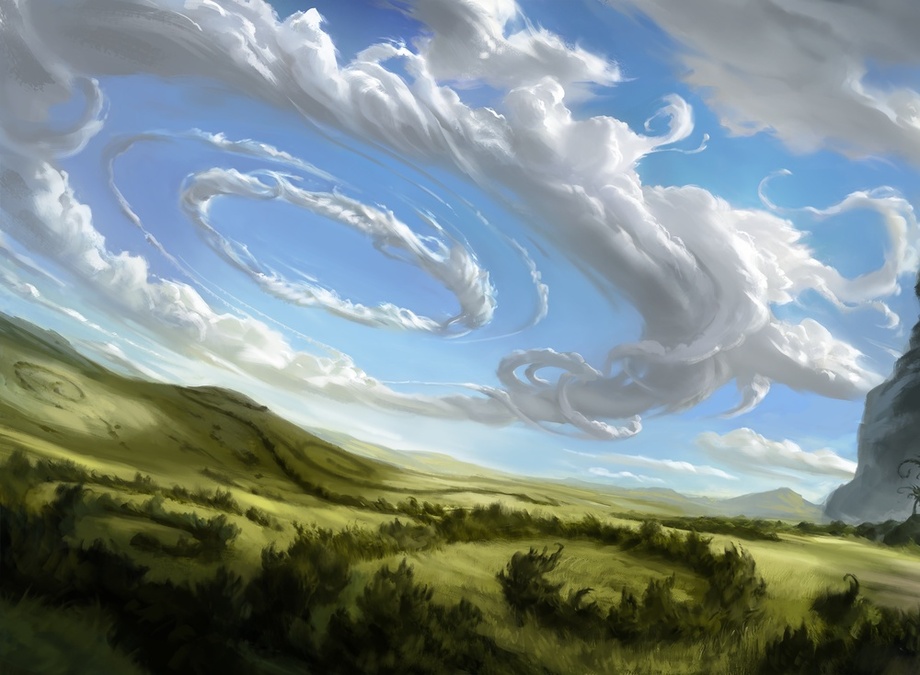
Plains (Magic Fest 2019) by Sam Burley. Digital.
When Sam Burley’s promotional basic lands for Magic Fests 2019 were revealed, it was like Vorthos Christmas morning as it became apparent that each had its own plane-specific location. A few hours later the artist revealed it was actually a panorama, with all five pieces of art connected, and the #mtgart Twitterverse lost its mind. The Plains from this series is wonderfully playful. The swirls that take us back to Kaladesh are one of my favorite design components; they create movement in an otherwise static environment, generating nostalgia for a world we remember as well as helping to compel our eyes to move through the rest of the monumental work. I don’t have any of these basics currently, but they’re certainly on my short list.
Plains #231 (Magic 2010) by John Avon
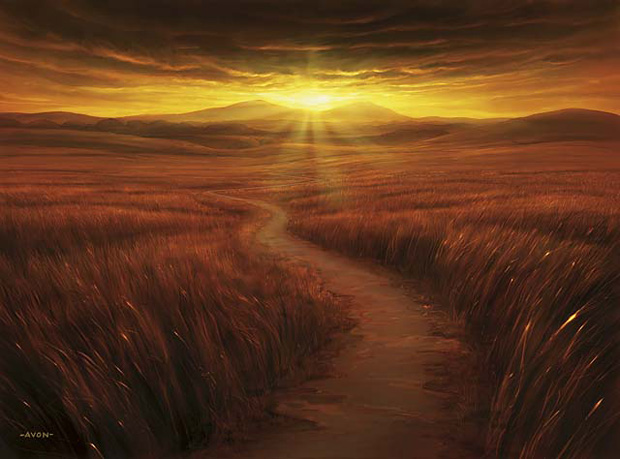
Plains #231 (Magic 2010) by John Avon.
Close your eyes. Well, actually look at the Avon painting above, hit play here, then close your eyes and listen. Although the palette isn’t exactly as we see in the movie, this painting has always reminded me of when Maximus goes “home” in Gladiator, a final journey to the sunset to be with those he loves. I can’t help but hear the music every time I see it, and it’s a just one example and testament to the Constructive power that Basic Lands can have. This land is also in Core Set 2020, and allows me to relive this feeling again and again.
Plains #233 (Magic 2010) by Ryan Pancoast
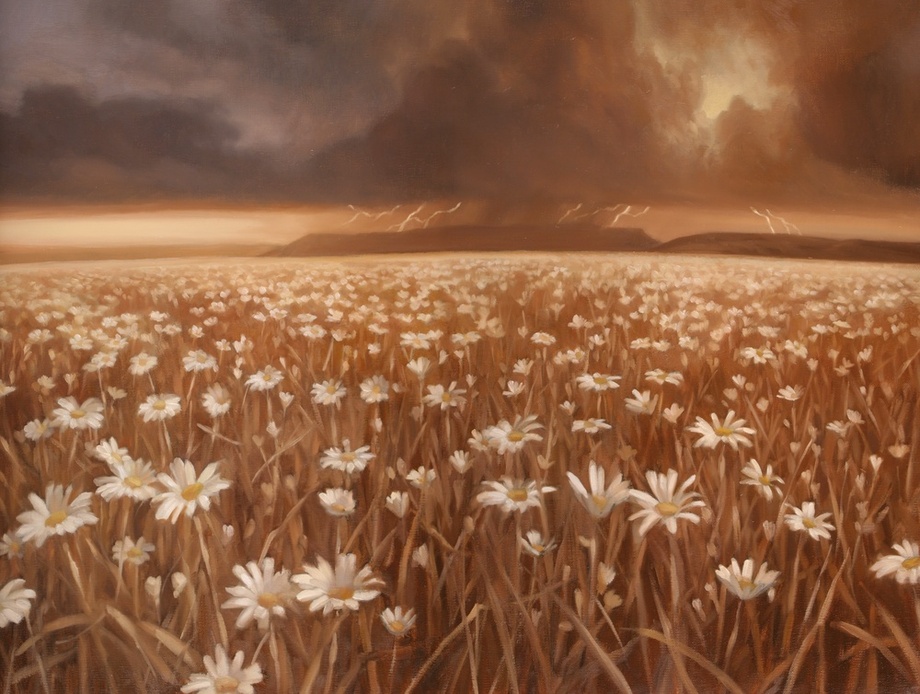
Plains #233 (Magic 2010) by Ryan Pancoast. Traditional. Private Collection.
This painting was Ryan Pancoast’s first commissioned work for Magic, and has been quite popular since its initial inclusion in a Core Set a decade ago. It actually tells the story of Ryan’s Coast-to-Coast race with his college team in art form. Seeing it in large format shows the wonderful brushstrokes of the flowers, and the storm in the background is almost impossible to witness at card size. I play this Plains in my Pancoast Vintage Artist Constructed deck, and you can also now own this work on a limited edition playmat while they last.
Plains #B1 (Ravnica Weekend) by Alayna Danner
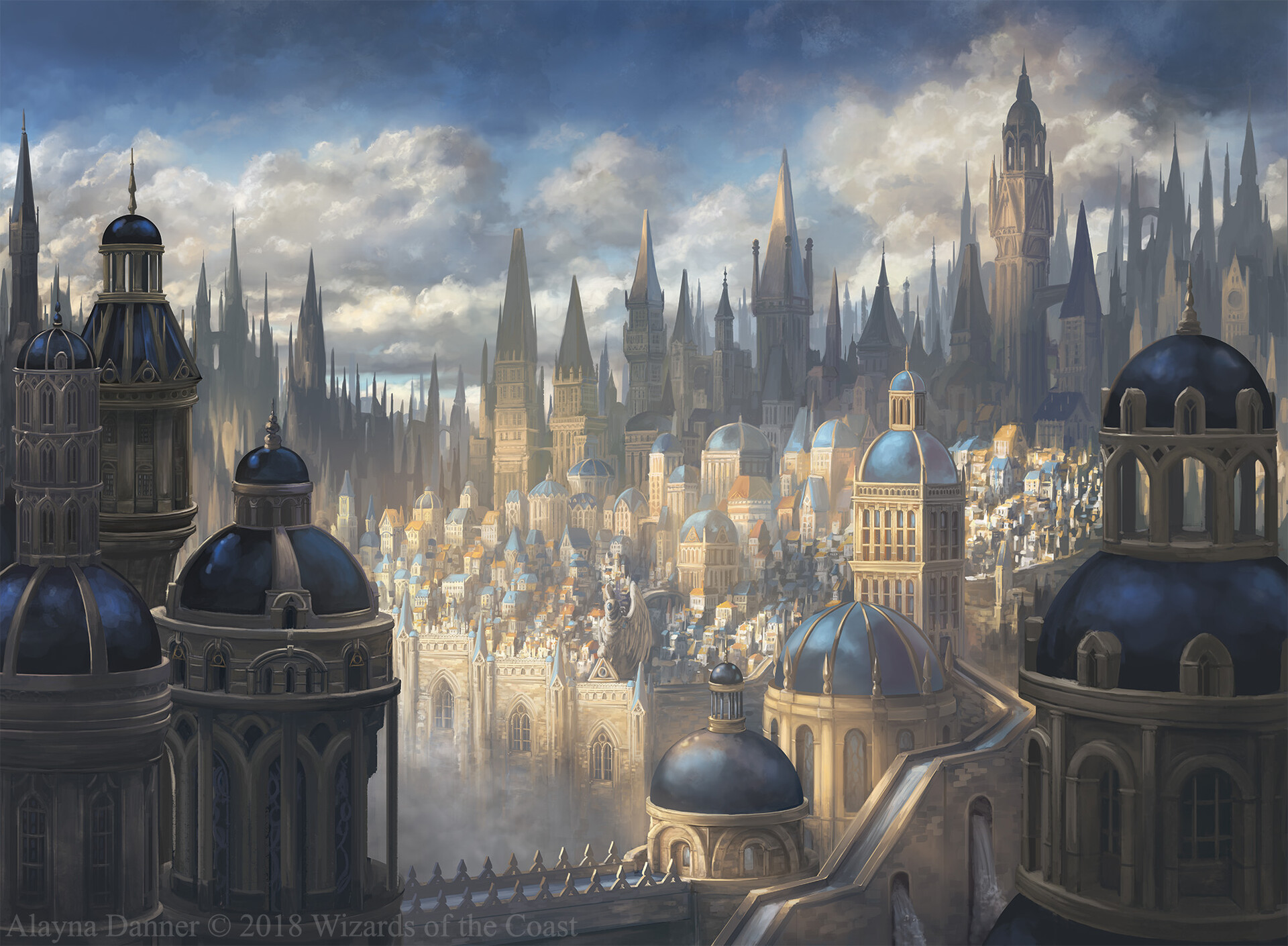
Plains #B1 (Ravnica Weekend) by Alayna Danner. Digital.
Magic’s latest visit to Ravnica introduced elaborately themed Guild lands as promotional cards for Ravnica Weekend, and Danner’s Azorius Plains-Island Diptych is a simply stunning addition to the series. Her azure-roofed towers of the Azorius district proclaim the guild’s emphasis on law and order, as buildings are neatly tucked together to mimic stalks of wheat on a more typical plain.
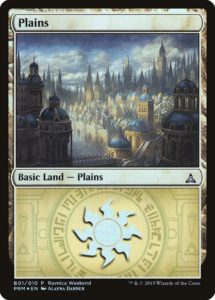
This art is breathtaking at card size as well as full size, and I think will remain a staple inclusion for Azorius-themed decks for a long time.
Plains #288 (Mirrodin) by Rob Alexander

Plains #288 (Mirrodin) [with Ancient Den] by Rob Alexander. Traditional.
Plains #287 (Ravnica: City of Guilds) by Stephen Martiniere
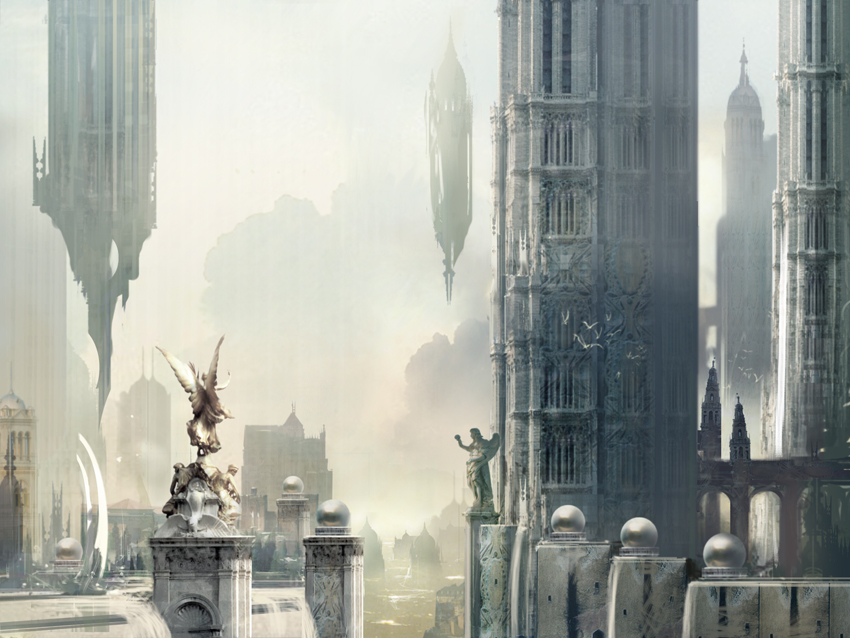
Plains #287 (Ravnica: City of Guilds) by Stephen Martiniere. Digital.
When the original Ravnica was released, it furthermore changed how Basic Lands could depict a world forever. I remember still being in high school and seeing the Martiniere lands, this one in particular, and thinking how much is was like nothing I’d ever seen before. The white marble and blinding light make the Lord of the Rings’ Minas Tirith a playable basic land in Magic, and at the same time made it okay for Plains not to be never-ending fields.
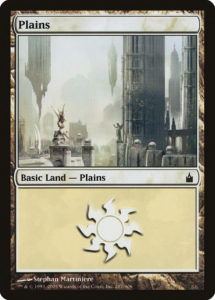
A city as a land had never been done before, and this work alongside its counterparts literally changed the way we could see a world. They will hold an important place in the art history of the game forever.
Plains #190 (Hour of Devastation) by Lars Grant-West
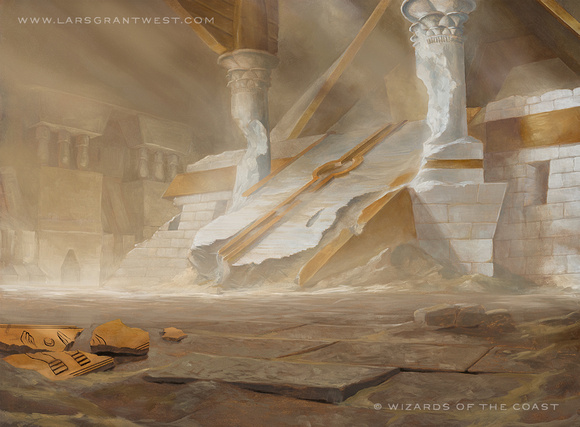
Plains #190 (Hour of Devastation) by Lars Grant-West. Traditional. Private collection.
One of the most atypical Plains designs, Grant-West’s faltering temple is yet another novel take on how different a Basic Land can be. While it’s true Amonket and Hour of Devastation lands could have all been desert and rubble, this painting captures a moment in time inside of a holy place—a perfect and very unique setting for what’s happening. I saw this work up close at IlluxCon in 2017, and had it not been sold by the time I got to this booth I probably would have purchased it; the story-telling is top-notch, as is the painting itself.
While it doesn’t happen often, it’s always a treat when Lars Grant-West is commissioned a basic land because you know he’s going to give you something both unconventional and fabulous like this great illustration.
Plains #252 (Dominaria) by Dimitar Marinski
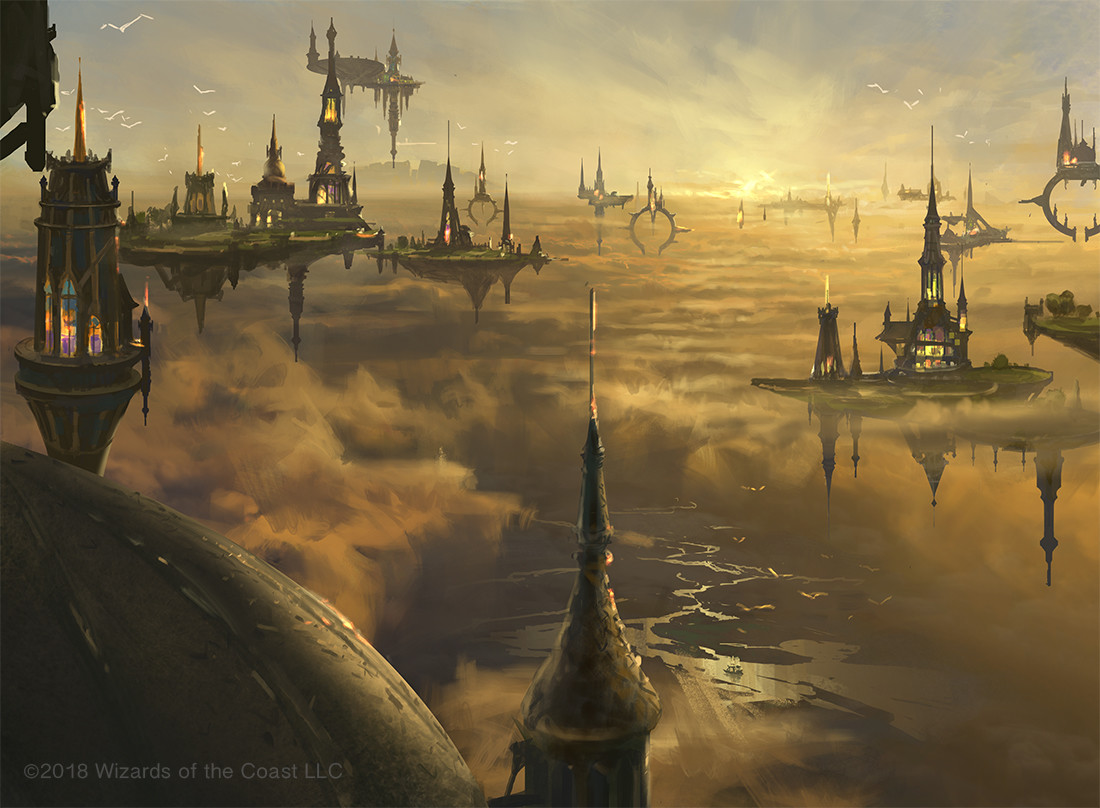
Plains #252 (Dominaria) by Dimitar Marinski. Digital.
On rare occasions in Magic we get to see a glimpse of “heaven,” and that’s exactly what Dimitar gives us here: a lens into the angelic world on Dominaria, not unlike Serra’s Realm that came before it. Floating buildings have been associated with Magic’s angels for more than twenty years, and his rendition creates a surreal feeling of dwelling amongst them. I own exactly zero of these lands, but a group of foils would be perfect for a Serra, the Benevolent Oathbreaker deck or to use alongside Commander Lyra Dawnbringer to make the deck theme stand out.
Wrapping Up
I hope you enjoyed this short trip through just 6% of the Plains in Magic’s history. I fully realize I left out lots of folks favorites but I sure would like to know them, so please make sure you head on over to Twitter to tell me which Plains you like best and share an image of the art. I think Ryan Sainio will be doing a similar article with his favorites soon, so make sure to keep on the lookout for that as well.
Looking forward as we head into the dog days of summer, I’ve got yet another Art Grand Tour for Core Set 2020 (so many sets!), as well as an in-depth look at a July heat thematic trio of color studies that have just come back from the framer. The Magic Art Show at IX 12 is also continuing to gear up, so expect to hear more on that as well.
Remember, to see original #mtgart and other #vorthos related things, follow me on Twitter. Feel free to ask questions or retweet to continue the conversation. Thanks and see you next time!
Donny Caltrider has been playing Magic since 2002 and collecting original Magic art since 2017. He has an M.A. in Museum Studies from Johns Hopkins University and enjoys telling stories about art, objects, and the intersection of fantasy with real-life. You can find him on Twitter talking about #mtgart, museums, and other #vorthos related goodness. Follow along and continue the conversation!

